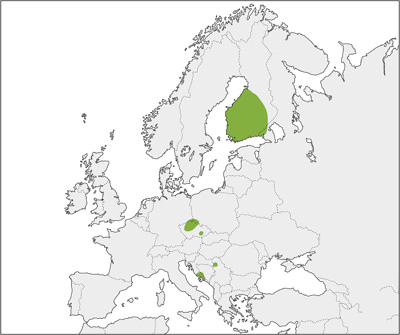
Odocoileus virginianus
White-tailed Deer with doe. TLA.

White-tailed Deer have a reddish brown coat with a whitish throat and belly. The inside of the ears is white, and there is a white ring around the eyes and snout. White-tailed Deer are a little larger than Fallow Deer and somewhat smaller than Red Deer; they measure 90–105 cm at the shoulder, weigh 50–135 kg, and are about 115–170 cm long, with a relatively long tail of 15–28 cm, which is brownish above and white below. When running, the animal raises its tail, and the white area on the underside becomes visible.
The stag is larger than the doe. The antlers have three or four crowns, and they are shed each December.
White-tailed Deer are very much tied to specific locales and can often be seen at woodland edges where there is access to fields, also in larger clearings. They prefer deciduous forest near open fields but will forage for food in agricultural land. They may also visit gardens. They feed on shoots and leaves of deciduous trees, but also graze on conifers. In summer they live in small family herds, and in winter in larger groups of up to 25 individuals. If threatened, they sometimes stomp the ground and emit a baying sound.
White-tailed Deer are native to North America. They were introduced into Finland in 1934, where there is now a large population in the southern part of the country; otherwise, apart from those in zoos and deer parks, smaller populations reside in the Czech Republic, Serbia, and Croatia.
The footprint is elongated and narrow and resembles that of a Fallow Deer; it is about 7 cm long and 4 cm wide, and may be splayed. The stride is about 90 cm; when the animal is galloping, the stride increases and can reach 180 cm or more in length.
The scat resembles that of Fallow and Red Deer, each individual ‘grape’ about 1.5–2.5 cm long and 1–1.5 cm wide.
